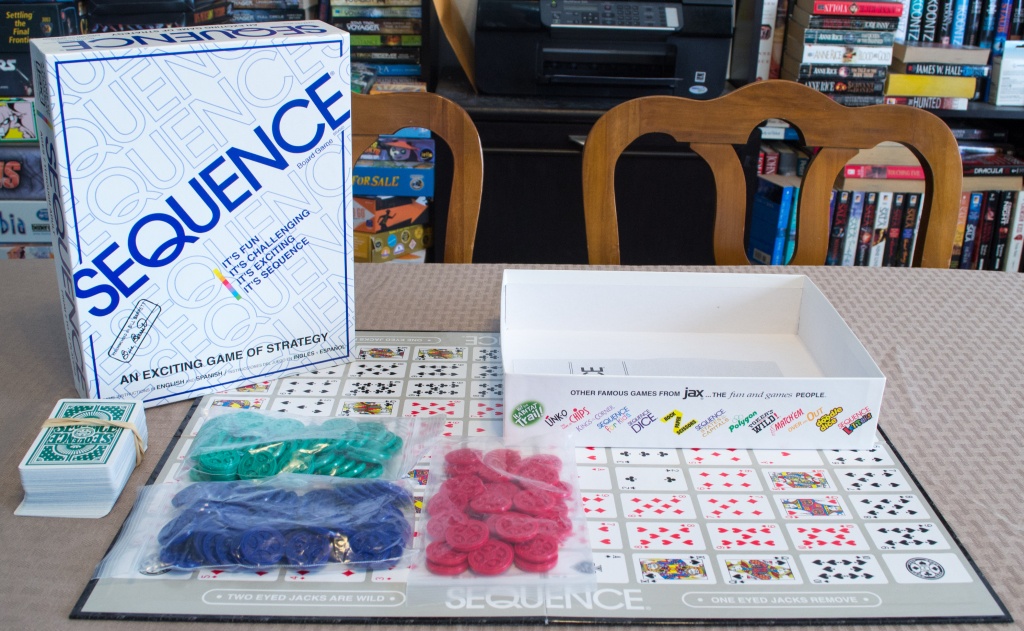I don’t remember much about my early childhood, but I do recall a game that featured both cards and a board with matching card spaces. It was one of those games you found in your grandmother’s closet that never saw the light of day (as far as you knew anyway), but looked like a lot of fun. Unfortunately, I wasn’t one for reading directions back then…I just sort of made it up as I went. I had an active imagination, what can I say? At any rate, I was browsing Amazon the other day and came across “Sequence”…needless to say something clicked inside my head when I saw the product pictures. It was only about fifteen bucks to boot so I took a chance. Was I disappointed? Keep on reading to find out!
Editor’s Note: The game is best played with two or three players, or in teams of two or three.
Components
Cards – The game includes two standard decks of playing cards.
Chips – Three sets of chips are includes, each consisting of a different color.
Board – The board consists of a 10×10 grid, with each space representing a particular card. Each card is pictured twice on the game board, except for the jacks.
Setup & Gameplay
Each player/team receives a set of tokens and the dealer is determined via a card draw (lowest card deals). The dealer then shuffles the deck and deals out a set number of cards to each player, the number of which is based on how many people are playing the game. If you’re playing in teams, its important that all of the players on the same team are using the same colored chips. The red chips are only used in three player/teamed games.
A player can take the following actions on their turn:
1. Discard a Dead Card (optional) – If the current player has a card in their hand that cannot be played (because its spaces are already occupied by chips), they may discard it into their own discard pile and draw a new card into their hand.
2. Play a card – The player selects a card from their hand and places it into their discard pile. They’ll then place one of their tokens on a matching space on the board. Playing a one-eyed jack allows the player to remove a chip from the board, while the two-eyed jack acts as a wild card (allowing the player to place a chip anywhere).
3. Draw a card – After playing a card, the player may draw a card from the deck. Forgetting to do so will simply mean you have fewer cards to work with for the rest of the game, so don’t forget!
Play continues clockwise until a player or team scores the required number of sequences (five tokens in a row). The required number of sequences will change based on how many people/teams are playing the game.
The above doesn’t cover all of the rules found in the manual, but should give you an idea as to how the game is played. For more information, you can view the rule book here:
http://www.jaxgames.com/seq2.htm
The Review
I’ll opt to keep this review short, namely because the game is so simple to play and because there’s not much to talk about. There’s more of an emphasis on luck as opposed to strategy, though you will sometimes have a choice on which space you’d prefer to place your token. As such, this game is much better suited to be a casual, family-friendly game. Hardcore strategy game players might enjoy this as a filler in between longer play sessions, but some might find it to be too light for their liking. I myself consider this to be a moderately fun game, one that I don’t have to devote too many brain cells to…perfect for nights where my workday has not been kind to me. It’s easy to pick up and play, making it ideal for players of almost all ages. Jokers are included in the decks and not mentioned in the rules, though imaginative players can include them and create variants to their heart’s desire. To that end, there isn’t a casual gamer family that shouldn’t have this in their collection.
Final Verdict: 7/10
—
You can learn more about and purchase “Sequence” by visiting the following websites:
http://www.jaxgames.com/seq.htm
—


